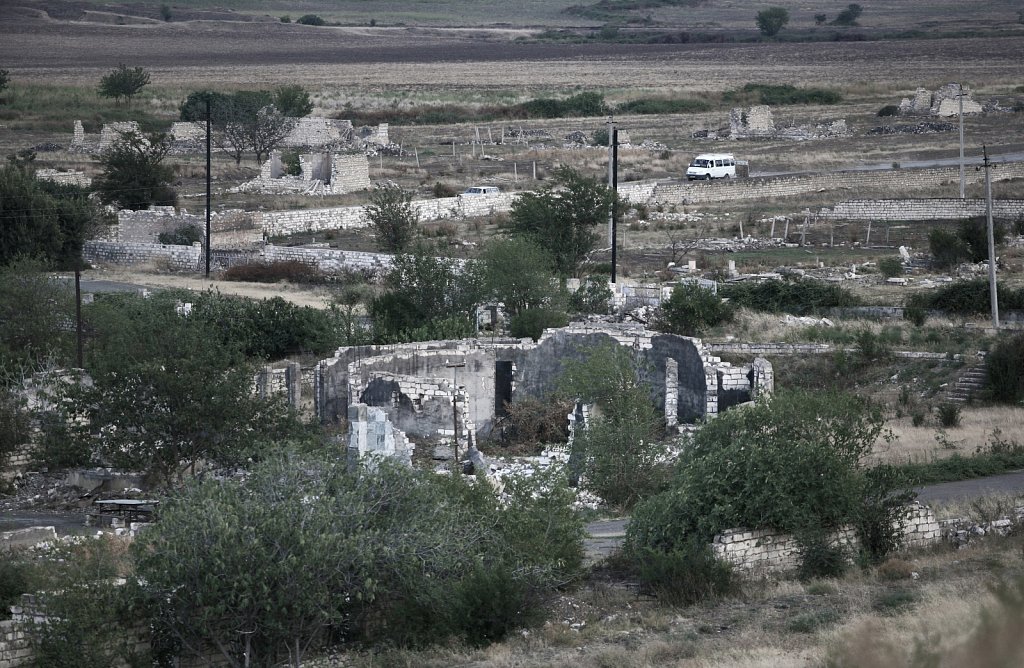
Nagorno-Karabakh
The ruins of Aghdam, city at the borderline between Nagorno-Karabakh and Azerbaijan has been totally destroyed during the armed conflict and afterwards. It is now a ghost-city, who once had it's own airport and a population of 160.000. Being on the borderline, there are still fights going on in this area which is considered a buffer zone between the two countries. The place is also known to be dangerous for it's unexploted mines. There is no official report of mines left unexploded, but it is certain that Nagorno-Karabakh is one of the former Soviet Union territories with the greatest area of minefields. Aghdam, Nagorno-Karabakh, 19 September 2008.

Nagorno-Karabakh
The ruins of Aghdam, city at the borderline between Nagorno-Karabakh and Azerbaijan has been totally destroyed during the armed conflict and afterwards. It is now a ghost-city, who once had it's own airport and a population of 160.000. Being on the borderline, there are still fights going on in this area which is considered a buffer zone between the two countries. The place is also known to be dangerous for it's unexploted mines. There is no official report of mines left unexploded, but it is certain that Nagorno-Karabakh is one of the former Soviet Union territories with the greatest area of minefields. Aghdam, Nagorno-Karabakh, 19 September 2008.

Nagorno-Karabakh
The ruins of Aghdam, city at the borderline between Nagorno-Karabakh and Azerbaijan has been totally destroyed during the armed conflict and afterwards. It is now a ghost-city, who once had it's own airport and a population of 160.000. Being on the borderline, there are still fights going on in this area which is considered a buffer zone between the two countries. The place is also known to be dangerous for it's unexploted mines. There is no official report of mines left unexploded, but it is certain that Nagorno-Karabakh is one of the former Soviet Union territories with the greatest area of minefields. Aghdam, Nagorno-Karabakh, 19 September 2008.

Nagorno-Karabakh
The ruins of Aghdam, city at the borderline between Nagorno-Karabakh and Azerbaijan has been totally destroyed during the armed conflict and afterwards. It is now a ghost-city, who once had it's own airport and a population of 160.000. Being on the borderline, there are still fights going on in this area which is considered a buffer zone between the two countries. The place is also known to be dangerous for it's unexploted mines. There is no official report of mines left unexploded, but it is certain that Nagorno-Karabakh is one of the former Soviet Union territories with the greatest area of minefields. Aghdam, Nagorno-Karabakh, 19 September 2008.

Nagorno-Karabakh
A grup of cows are grazing next to a water supply pipe deliberately pricked to lower the pressure inside the pipes and to irrigate the lands, Aghdam region, Nagorno-Karabakh, 19 September 2008.

Nagorno-Karabakh
A residential district is seen from a window in Khojaly city, Nagorno-Karabakh. The city is a military base, situated near the border with Azerbaijan and 10 km Northeast of the capital Stepanakert. The city is known for the Khojaly Massacre committed on 25–26 February 1992 by the Armenian and, partially, by CIS armed forces (the Russian 366th Motor Rifle Regiment) during the Nagorno-Karabakh War. Khojaly, Nagorno-Karabakh, 19 September 2008.

Nagorno-Karabakh
A dryer room in an apartment block in Khojaly city, Nagorno-Karabakh. The city is a military base, situated near the border with Azerbaijan and 10 km Northeast of the capital Stepanakert. The city is known for the Khojaly Massacre committed on 25–26 February 1992 by the Armenian and, partially, by CIS armed forces (the Russian 366th Motor Rifle Regiment) during the Nagorno-Karabakh War. Khojaly, Nagorno-Karabakh, 19 September 2008.

Nagorno-Karabakh
Women talk in the hallway of an apartment block in Khojaly city, Nagorno-Karabakh. The city is a military base, situated near the border with Azerbaijan and 10 km Northeast of the capital Stepanakert. The city is known for the Khojaly Massacre committed on 25–26 February 1992 by the Armenian and, partially, by CIS armed forces (the Russian 366th Motor Rifle Regiment) during the Nagorno-Karabakh War. Khojaly, Nagorno-Karabakh, 19 September 2008.

Nagorno-Karabakh
A woman fills the plastic buckets with water in front of an apartment building damaged during the war period, in Khojaly city, Nagorno-Karabakh. The city is a military base, situated near the border with Azerbaijan and 10 km Northeast of the capital Stepanakert. The city is known for the Khojaly Massacre committed on 25–26 February 1992 by the Armenian and, partially, by CIS armed forces (the Russian 366th Motor Rifle Regiment) during the Nagorno-Karabakh War. Khojaly, Nagorno-Karabakh, 19 September 2008.

Nagorno-Karabakh
An apartment block is seen in Khojaly city, Nagorno-Karabakh. The city is a military base, situated near the border with Azerbaijan and 10 km Northeast of the capital Stepanakert. The city is known for the Khojaly Massacre committed on 25–26 February 1992 by the Armenian and, partially, by CIS armed forces (the Russian 366th Motor Rifle Regiment) during the Nagorno-Karabakh War. Khojaly, Nagorno-Karabakh, 19 September 2008.